Why Are Goals Important for Self-Care?
DISCLOSURE: This post may contain affiliate links, meaning I make a commission if you purchase through my links, at no extra cost to you. For more information, please read my Disclaimer.
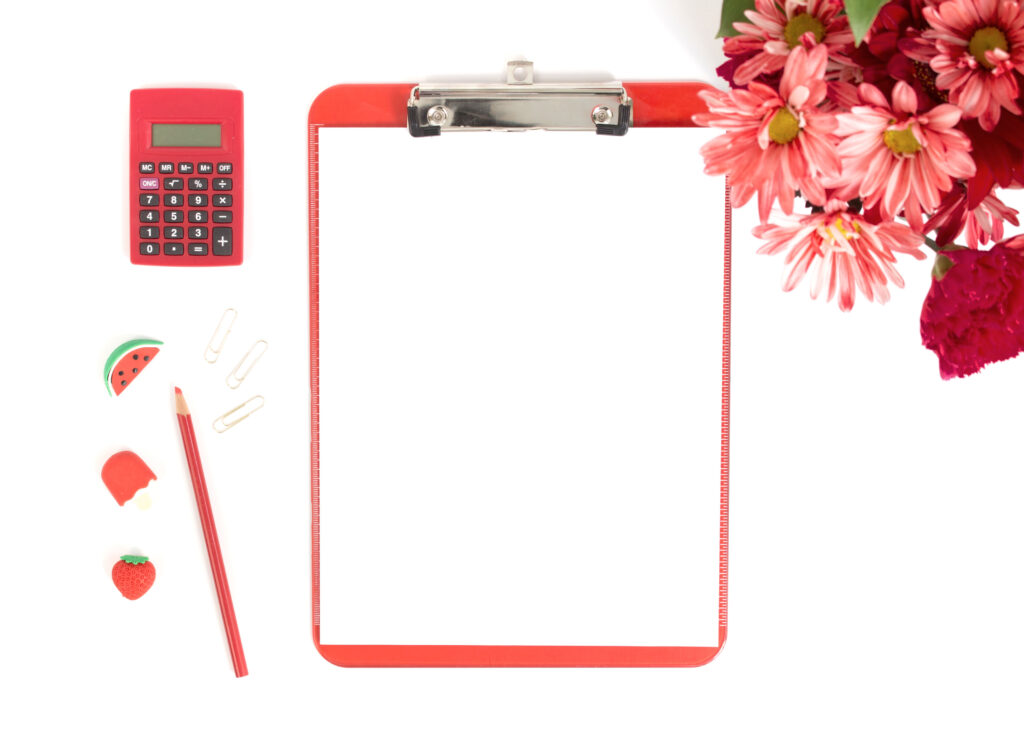
In this article, you will learn why are goals important—especially when it comes to self care. In today’s fast-paced society, we are constantly bombarded with messages that glorify hustle culture. This “go-go-go” mentality often leads to burnout, overwhelm, and poor mental health.
When we look at the big picture of our lives, it’s easy to feel buried under the weight of everything we need to do and all we hope to accomplish. Personally, I used to feel completely overwhelmed just thinking about all the things on my to-do list. I’d get stuck in analysis paralysis—defeated before I even started.
That’s when things began to shift. I sat down and asked myself, why are goals important? What would happen if I actually wrote them down and made a plan? That intentional decision marked the beginning of a new chapter. I started writing goals for the various areas of my life, and surprisingly, it felt like self care. Choosing to get organized and clear on my next steps helped me take control of my mental health and reduce anxiety.
Why Are Goals Important?
Once I started setting goals, I noticed an immediate change. I felt more peaceful and less anxious. Instead of trying to tackle the entire mountain, I began climbing one step at a time. Each small, achievable goal brought a sense of victory and helped me move forward.
So, why are goals important? Because they give your actions purpose and direction. A goal is your target—the destination you’re aiming for. Goals can be short-term or long-term, big or small, but all of them help you focus your energy instead of scattering it.
While it’s helpful to set a completion date, don’t be discouraged if you need to adjust it. Life happens. The key is to keep moving forward. Progress is still progress, even if it’s slower than you expected. I’ve had to modify goals before—sometimes I didn’t factor in all the challenges—but instead of quitting, I reevaluated and kept going.
Goal-Setting as a Self Care Practice
When I began creating goals, I looked at every area of my life:
- Spiritual
- Relationships
- Financial
- Physical health
- Mental health
- Education
- Household
- Business
These areas matter to the life I want to live—and that’s why I set goals for them. You should choose areas that matter most to you. If you’re unsure, I recommend reading my article on writing the vision for your life. A clear vision gives your goals a destination—without it, you may end up working hard in the wrong direction.
Here’s how I set up my goal-setting process using a simple notebook system:
Check out my Amazon storefront for some great recommendations.
Step 1: Write the Big Picture Goal
Start by writing your big-picture goal under each area of life. This isn’t the exact goal you’ll work on right away, but it’s the destination you’re moving toward.
For example, my husband and I have a long-term financial goal of saving $100,000. That’s a huge goal—and not one that’s achievable overnight. So I break it down. A smaller goal might be to save $1,000. That’s realistic and measurable.
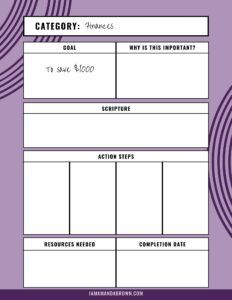
Step 2: Ask Yourself—Why Is This Goal Important?
This is key: Why are goals important to you personally? What’s the reason behind what you’re working toward? Without a solid “why,” it’s easy to lose motivation. When the goal has meaning, you’re more likely to stay committed.

Step 3: Find a Scripture to Anchor Your Goal
As a believer, I want my goals to align with God’s Word. One verse I use for financial goals is Proverbs 21:20 (AMP):
“There is precious treasure and oil in the house of the wise [who prepare for the future], But a short-sighted and foolish man swallows it up and wastes it.”
This helps me stay grounded and reminds me why stewarding money wisely matters.

Step 4: Write Out Actionable Steps
Break your goal into doable steps. For example, if your goal is to save $1,000, your steps might include:
- Write a monthly budget
- Set aside a specific amount from each paycheck
- Cut unnecessary spending
- Sell unused items around the house
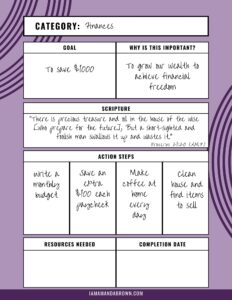
Step 5: List the Resources You Need
Think through what tools or resources you’ll need. For a savings goal, this might be:
- A savings account
- A budget template
- Cash envelopes or a budgeting app
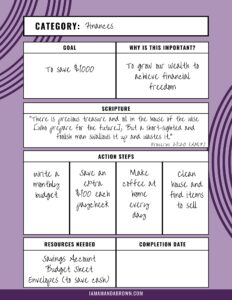
Step 6: Choose a Completion Date
Set a target date that’s both realistic and motivating. Avoid setting extreme or unhealthy goals (like losing 50 pounds in a month). A practical timeline gives you structure without pressure.
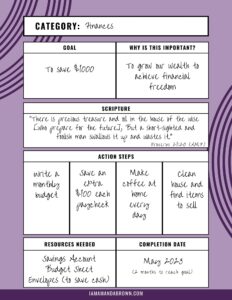
Setting goals is more than just writing down a dream—it’s an intentional act of self care and personal growth. When you understand why goals are important, you begin to approach life with strategy instead of stress.
I’ve included the goal-setting sheets I use for myself. Feel free to download them or create your own version to fit your style. And remember: small steps add up. Your future self will thank you for every goal you take seriously today.
Click the image below to download your free goal setting sheets.
If this post resonated with you, then my workbook, You Don’t Actually Suck: A Guide to Seeing Yourself Through God’s Lens and Not Your Own, is exactly what you need. This guide will help you break free from negative self-talk, replace lies with truth, and learn to see yourself the way God sees you—worthy, loved, and full of purpose.
Inside, you’ll find practical exercises, biblical encouragement, and space to craft affirmations that speak life over yourself. Don’t let negativity hold you back any longer—start rewriting your inner dialogue today!






